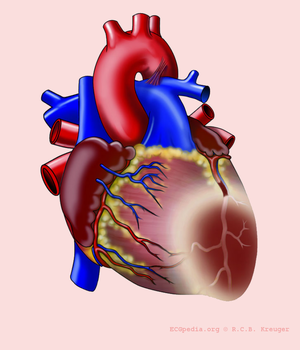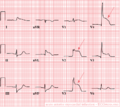Anterior MI: Difference between revisions
Jump to navigation
Jump to search
mNo edit summary |
mNo edit summary |
||
| Line 5: | Line 5: | ||
[[Image:heart_with_AL_infarct.png|thumb|Anterolateral infarct caused by occlusion of the LAD.]] | [[Image:heart_with_AL_infarct.png|thumb|Anterolateral infarct caused by occlusion of the LAD.]] | ||
Encomprises the anterior part of the heart and a part of the ventricular septum. Is supplied by blood by the LAD. | Encomprises the anterior part of the heart and a part of the ventricular septum. Is supplied by blood by the LAD. | ||
{{clr}} | {{clr}} | ||
| Line 11: | Line 11: | ||
<gallery> | <gallery> | ||
Image:AMI_anterior.png|A typical example of an acute anterior wall infarction. ST elevation in leads I, AVL and V2-V5. Reciprocal depressions in the inferior leads (II,III,AVF) | Image:AMI_anterior.png|A typical example of an acute anterior wall infarction. ST elevation in leads I, AVL and V2-V5. Reciprocal depressions in the inferior leads (II,III,AVF) | ||
Image:ECG_VWI_2wk.jpg|A 2 weeks old anterior infarction with Q waves in V2-V4 and persisting ST elevation, a sign of formation of a [[Cardiac_Aneurysm|cardiac aneurysm]]. | |||
</gallery> | </gallery> | ||
Revision as of 20:42, 22 July 2007
| This is part of: Myocardial Infarction |
ECG-characteristics:[1]
ST-elevation in leads V1-V6, I and aVL. Maximum elevation in V3, maximal depression in III later: pathological Q-wave in the precordial leads V2 to V4-V5.
Encomprises the anterior part of the heart and a part of the ventricular septum. Is supplied by blood by the LAD.
Examples
A 2 weeks old anterior infarction with Q waves in V2-V4 and persisting ST elevation, a sign of formation of a cardiac aneurysm.


